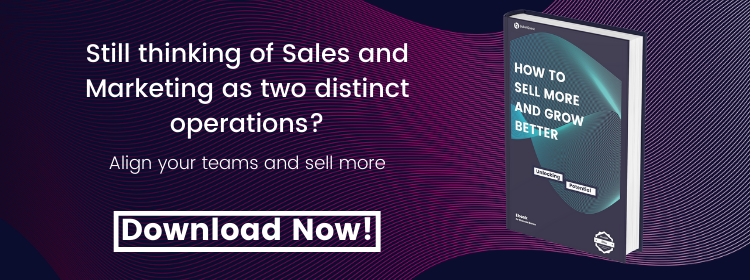A sales enablement framework can transform the way your whole team operates. This one will help them to have meaningful conversations with their prospects, particularly across social media.
As buzzwords go, 'social selling' is up there at the top. It’s a meaningless phrase that has the wrong connotations and generally drives the wrong behaviours. Very few people will actually 'sell' via social channels.
What they will do is have interesting interactions with relevant people via social channels, with the potential to improve sales performance and drive new business if they are able to successfully lead the prospect from digital interaction to real conversation.
This is where the challenge lies. So what steps can today's reps take to help them drive revenue growth through social engagement?
Is your team following this 7-step sales enablement framework?

1. Turn cold calls into warm ones
Any question with the dreaded words 'cold calling' in the mix is bound to get your hackles up, but you need to consider it if you engage in social selling. How do you turn what could seem like a 'cold' call into a 'warm' one?
Even in the short time that social selling has been a thing, it’s become apparent that the majority of salespeople are pretty good at being helpful and engaging online, but struggle with maintaining that 'helpful' persona once they get a hard won prospect on the phone.
2. Start each call with recognition
The first piece of training most salespeople (should) get before their first sales call is to introduce yourself and pause for recognition. If you're calling someone off the back of a social interaction, doing this is going to tell you whether the interaction was meaningful.
If you call and say 'Hi, it’s Chris from BabelQuest', and they recognise you, you know that your social interaction was worthwhile and you have their attention. If they don’t recognise the name, you know you would've wasted your time.
3. Prequalifying for prospect fit
In any sensible B2B sales operation, you should have a clear awareness of the sort of company that buys what you sell (turnover, size, sector etc.), as well as an idea of who's typically involved in a buying decision. You will also know the sorts of people that are influencers in your sector or whose opinion carries weight amongst their peers. Proper sales qualification is key to better productivity and more sales, even at this early stage.
If you are going to try to call someone you have been interacting with over social, make sure you pre-qualify them to see if it’s worthwhile. Look at their LinkedIn profile, their connections, and their company LinkedIn page. Do a quick search for news about their company, see if there is evidence of investment or innovation.
4. Context, context, context
If you're doing the social engagement right, you should have a pretty good picture of the person you are talking to’s company, situation, and interests. You might even have an idea of a problem they are trying to solve. This is context.
To build up a really powerful picture of a potential prospect, you are going to have to spend some time researching them beyond your social interactions. For example: people they have connected to recently might give you an indication that they are talking to your competitors, which in turn means they could be researching the problem you can help with. It could equally mean that you missed the boat and they've already bought!
If you can’t scribble down answers to the following questions you don’t have context:
- Who are they, who are they connected to, where do they fit into their world?
- What are they interested in? what have they posted or shared?
- How do they communicate?
- Where do they post or share content?
- Why do you think it’s worth trying to take the conversation beyond social? Why do you think they will be interested in talking to you?
Learn more and increase your reps' average quota attainment by 31% using this sales enablement boot camp.
5. The right questions?
Pre-qualification and context are vital, but if you pick up the phone and launch into a sales pitch, even one that's carefully tailored to the prospect, you're probably embarking down the road to unreturned voicemails, “just checking in” emails and endless conversations with gatekeepers.
The right questions will change the dynamic of a call from the start, so it’s worth spending some time working out what sort of questions you are going to ask before picking up the phone.
Don’t fall into the trap of preparing questions that are aimed at moving the conversation into a sales pitch as soon as possible. I mean the sort of questions that will actually make your prospect want to answer and are based on the interactions you have had with them.
6. Can you add any value?
While research shows that the least valuable part of any sales process for a prospect is the first interaction with the sales person, moving from 'hello' to product vomit as fast as possible is not the solution.
It’s hard to add value if you don’t know anything about the prospects situation or what they value, hence the importance of research and context. In the first call you have to earn the right to defer value for later on in the process and that comes from context and relevant questions.
Discover how marketing automation can help your sales team to nurture and close more leads.
7. Conversation and patience
Once you have asked your well thought out question, listen. The mute button on your phone is your friend. Get all thoughts of selling something out of your head, even if the prospect looks like they are ready to buy now. You tapped them up on social, started a conversation, and then called them out of the blue — would you buy from that person immediately?
The main purpose of your call is to work out whether there is a conversation to be had rather than a sale to be made. Don’t mess up all your hard work by going in for the kill. Your deal strategy should involve being patient, demonstrating that you're worth talking to, and establishing rapport.
There are only ever going to be three outcomes to the call (advance, nurture, disqualify). They're unlikely to start writing cheques there and then, so be mindful of this and have an actual human conversation. It’s guaranteed to make you stand out.
The benefits of following this sales enablement framework
You won't transform your sales team overnight and there will be points where you feel frustrated with your reps' progress. This is where process comes in. Making and implementing one is essential for ensuring your sales team is operating consistently and with the best chance of success.
A social selling process can be a simple as:
- Research the prospect. Is there a fit? If not, move on.
- Gather context. Why does it make sense to chat? If it doesn’t, don’t waste your time calling.
- Prepare relevant questions. Have 3-5 good questions pre-prepared and ready to go.
- Call but don’t try to sell. Instead, establish quickly whether there's actually a conversation to be had.
- Earn the right to defer adding value. Show understanding and ask good questions.
If you pick the right prospects to engage via social, there should be a point where you have enough context to put in a call and ask a meaningful question. Some prospects will want to talk and some won’t. If you get it right and work hard at it, those first calls will become easier and business will start rolling in.
To discover how to improve sales productivity and close more leads, click the image below and download our free sales ebook.
Heading
Separated they live in Bookmarksgrove right at the coast of the famous Semantics, large language ocean and many more stuff and more more more


A recovering salesperson, now turned consultant. I implement HubSpot for organisations, do clever things with HubSpot reporting and help sales teams become more productive.




.png?width=50)

.png?width=50)
.png?width=50)



































